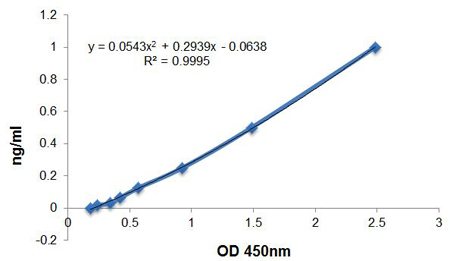Zinc-alpha-2-glycoprotein (human) (rec.) (untagged)
AG-40B-0146
Protein IDP25311
Product group Proteins / Signaling Molecules
Overview
- SupplierAdipoGen Life Sciences
- Product NameZinc-alpha-2-glycoprotein (human) (rec.) (untagged)
- Delivery Days Customer10
- CertificationResearch Use Only
- Estimated Purity>95%
- Protein IDP25311
- Protein NameZinc-alpha-2-glycoprotein
- Scientific DescriptionProtein. Human full-length zinc-alpha-2-glycoprotein (aa 21-298) is untagged. Source: E. coli. Endotoxin content: 95% (SDS-PAGE). Zinc-alpha-2-glycoprotein (ZAG), first identified in the 1960s, derives its name from its precipitation from human plasma upon the addition of zinc salts. ZAG has since been found in secretory epithelial cells and in a range of body fluids. ZAG is identical to a lipid mobilizing factor isolated from the urine of patients with cancer cachexia and stimulates lipolysis in in vitro and in vivo experiments. Due to its expression in, and secretion from adipocytes, ZAG is considered an adipokine. Recently the clinical significance of ZAG has been clarified. ZAG expression in adipocytes is inversely related to fat mass, thus it is intimately involved in the maintenance of body weight in mice and humans. Epidemiological studies have uncovered an association between ZAG and plasma cholesterol. The non-synonymous single nucleotide polymorphism rs4215 in ZAG is associated with plasma cholesterol and obesity. Structurally ZAG possesses a class I major histocompatibility complex (MHC) protein fold. It is distinct from other members of this protein family in that it is soluble, rather than being anchored to plasma membranes, and it associates with prolactin inducible protein rather than beta2-microglobulin. Similar to peptide antigen-presenting class I MHC molecules, ZAG possesses an open apical groove between its alpha1 and alpha2 domain helices. - Zinc-alpha-2-glycoprotein (ZAG), first identified in the 1960s, derives its name from its precipitation from human plasma upon the addition of zinc salts. ZAG has since been found in secretory epithelial cells and in a range of body fluids. ZAG is identical to a lipid mobilizing factor isolated from the urine of patients with cancer cachexia and stimulates lipolysis in in vitro and in vivo experiments. Due to its expression in, and secretion from adipocytes, ZAG is considered an adipokine. Recently the clinical significance of ZAG has been clarified. ZAG expression in adipocytes is inversely related to fat mass, thus it is intimately involved in the maintenance of body weight in mice and humans. Epidemiological studies have uncovered an association between ZAG and plasma cholesterol. The non-synonymous single nucleotide polymorphism rs4215 in ZAG is associated with plasma cholesterol and obesity. Structurally ZAG possesses a class I major histocompatibility complex (MHC) protein fold. It is distinct from other members of this protein family in that it is soluble, rather than being anchored to plasma membranes, and it associates with prolactin inducible protein rather than beta2-microglobulin. Similar to peptide antigen-presenting class I MHC molecules, ZAG possesses an open apical groove between its alpha1 and alpha2 domain helices.
- Storage Instruction-20°C,2°C to 8°C
- UNSPSC12352202



